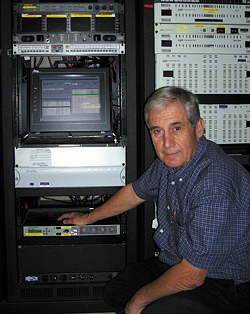EEG Eases HD Captioning Chores at WFLX
by Angelo (Butch) Figurella
Chief Engineer
WFLX Television
WEST PALM BEACH, FLA.
WFLX has long been a cornerstone of the Fox Television Network, and officially went on the air with live high-definition programming last January. High-definition broadcasting requires HD captioning, and for our engineering team that meant careful scrutiny of every aspect of our system for delivering closed captioning.
HD CAPTIONING ISSUES
Closed captioning for DTV carries its own set of challenges, and we wanted to be best prepared to transition to HD with as comprehensive an upgrade as possible—not just for delivery of captions to the screen, but also in terms of other issues including workflow and cost efficiency of the process.

Angelo (Butch) FigurellaClosed captioning encoders from EEG had already been part of our plan for some time, so we were interested to see what new solutions they had to offer. When we learned more about EEG's iCap, a secure real-time IP captioning system, we were very intrigued. Instead of analog modems and phone lines, it uses the Internet to manage closed captioning workflow—a digital approach that is a perfect fit with the mindset of an HD plant.
The more we looked into iCap, the more it made sense for the direction we wanted to take WFLX's captioning capabilities. As iCap uses IP connections, it provides our station—and the captioners that we work with—a number of improvements in terms of both convenience and operational ease. First off, the captioners receive audio that is greatly improved in quality. With iCap, they can also actually view the captions that they are writing as seen at our captioning encoder's output. This allows them to finally get the feedback that they're logged in, and that the system is fully functional from input all the way to broadcast output.
ENHANCED MONITORING
Monitoring any aspect of a broadcast is of utmost importance to us, and we've found that with EEG's iCap we have greatly enhanced capability for monitoring the closed captioning path. Now we have the ability to hear the audio that the captioners are hearing, and see the captions they write, either via master control or from the computer in my office. As a result, we can closely monitor for quality control, and check in to be absolutely certain that all aspects of the complete system are working perfectly. Obviously, this is a much higher level of control than we got from our previous dial-up modem system, which could tell you if the captioner was logged in, but virtually nothing else. EEG's iCap was also relatively easy to implement into our system, and once everyone obtained their passwords, it proved to be a smooth transition.
The reliability of the iCap software suite is right in line with what we've come to expect from EEG on the hardware side of things. If and when we need it, the support is responsive and we get the answers that we require right away. That's another important part of our overall philosophy on anything at WFLX—it should work well. EEG's iCap does, and I believe that's the reason that our station has experienced a seamless transition to high-definition closed captioning.
Angelo (Butch) Figurella has worked in television since 1960, beginning his career with an independent UHF operation. He has been with WFLX in West Palm Beach for the past 26 years. He may be contacted at bfiguerella@wflx.com.
For additional information, contact EEG Enterprises Inc. at 516-293-7472 or visit www.eegent.com.
The professional video industry's #1 source for news, trends and product and tech information. Sign up below.
